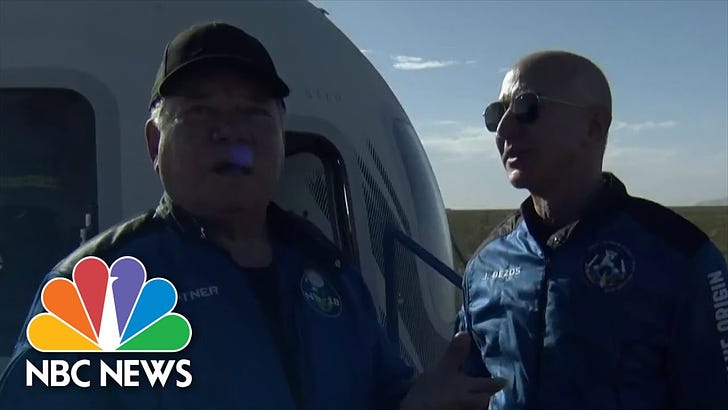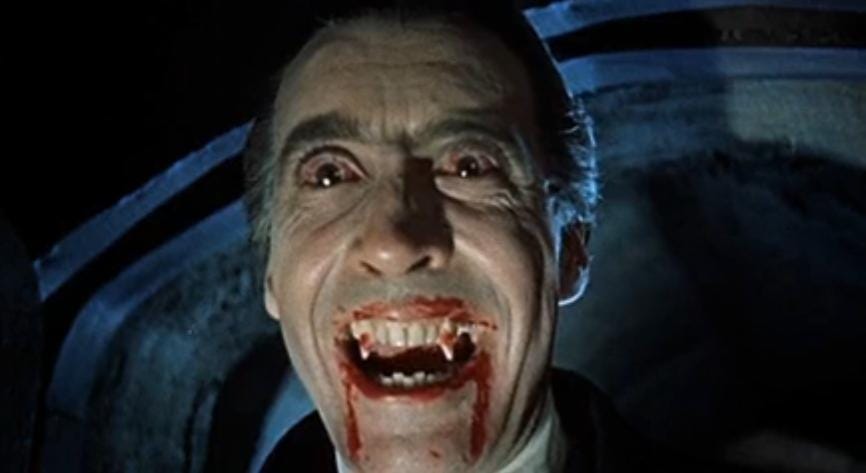Shatner's space jaunt was unifying. Plus: Superman's new identify. Hammer's Dracula
By Gary Abernathy
Shatner’s rocket trip was fun, unifying and well done
I was among those who were completely enamored with 90-year-old William Shatner’s voyage into space Wednesday on Jeff Bezos’ “Blue Origin” rocket. Watching life imitate art to this degree was amazing and, frankly, moving. It’s a testament to the power of Hollywood’s impact on our collective psyche that “Star Trek” and Captain James T. Kirk have such a powerful hold on our emotions.
Of course, it wasn’t always so true for the actor himself. In earlier years, Shatner famously shrugged off Kirk as just another acting job, and he poked fun at “trekkies” who took it all so seriously. “Get a life,” he dismissed them in a notorious “Saturday Night Live” sketch.
But that was actually understandable. Much like Adam West and “Batman,” “Star Trek” was, early on, something of a curse for Shatner and the other actors connected to the show. Typecasting was a career impediment. Leonard Nimoy wrote a book called “I’m Not Spock.” They may have been famous, but the royalties in those days weren’t a fortune, and other parts were hard to get because of their recognizability as Kirk, Spock, McCoy, etc.
But when the “Star Trek” movies came, starting in 1979, at least big money followed. Shatner also broke out with his “T.J. Hooker” cop series, and he was able to embrace Kirk once again without worrying about career roadblocks. In fact, as Adam West also discovered, running to, instead of away from, the characters that made them famous was the best choice at the end of the day.
Over the last few decades, Shatner has made Kirk his best friend. His Twitter feed is often hilarious, and he doesn’t shy away from joking with, and sometimes feuding with, other tweeters. The prickly side of his personality is well documented, including by former castmates. It’s unfortunate that his close friend, Nimoy, apparently fell out with him before his death.
But Shatner perseveres, and his energy and sharpness at 90 are impressive. His trip on Bezos’ rocket demonstrated real courage. Even though everything is automated and all he and the other passengers had to do was enjoy the ride, it’s a pretty unnerving ride to take. A million things could go wrong.
Watching it in real time was fun, and a little nerve-racking, too. When Shatner emerged, his comments to Bezos were memorable. Shatner has always been dramatic and a little over the top, but one felt his emotions were real.
Well done, Mr. Shatner. It was a nice, uplifting and unifying event in a world that needs more such moments.
Superman’s bi? Like all art, we can judge it for ourselves
In my new WaPo column, I discuss the news that Superman — at least the latest version of him — is bisexual. I write that the news was important to me, because “like millions of Silver Age comic book kids growing up with Superman in the 1960s, I feel a sense of ownership.” I add:
Superman and other superheroes of my youth, both male and female, were targeted to kids and devoted to thwarting evil. Their sex lives were irrelevant. The fact that Lois Lane was Superman’s girlfriend was understood, but that was as far as it went. If the pair kissed, it was usually in a dream sequence with Lois pining for her wedding day. Today, our graphic and sexualized society demands more, and our comic book heroes are marketed to mature audiences. The first image circulating with the news of Superman’s pending bisexual identification was that of a full-on kiss on the mouth between Superman and another man. Subtle.
But at the end of the day:
I have long objected to allegations of “appropriation” and the notion that art belongs to any particular group. Music, for example, is available to be reinterpreted by anyone, regardless of its origins. The same is true here — previously White and straight fictional characters can be repurposed as people of color or gay or bisexual. That doesn’t mean everyone has to embrace every new version of an old favorite.
You can read the whole column it here. A subscription may be required if you’ve exceeded the allotted free articles this month.
Talking about a disincentivized workforce on “Talkline”

I enjoyed being a guest with Hoppy Kercheval on his statewide West Virginia “Talkline” show on WVMetroNews on Wednesday. We discussed my recent WaPo column on how our plunge into socialism by spending trillions of dollars is killing the workforce. You can watch (while Skype cooperated) and listen by clicking above.
The Hammer ‘Dracula’ series created a new classic


As promised (or threatened), I’ll be reviewing some of my favorite horror films during this Halloween month.
When Hammer Studios in England began reimagining the classic Universal horror films of the 1930s and ‘40s, it took a few years for many fans such as myself to embrace them. I was devoted to Boris Karloff, Bela Lugosi, Lon Chaney Jr. and other actors whose films grabbed my imagination and devotion during their frequent showings on “Shock Theater”-style TV programs as I grew up in the 1960s and ‘70s.
But over the years, my appreciation of Hammer Horror has grown — particularly its Dracula series. Christopher Lee first donned the fangs for his 1958 debut as the vampire king. The film was known simply as “Dracula” in England, but “Horror of Dracula” in America to differentiate it from Lugosi’s original.
Unlike Lugosi’s slow and mysterious performance, punctuated by his thick Hungarian accent and broad stage mannerisms — all of which added to the weirdness of his Dracula — Lee was quick and articulate, his English accent adding to the Count’s first impression as an intelligent, well-studied gentleman. At 6’5, he was imposing.
After a prologue featuring Lee welcoming Jonathan Harker to his castle, his second appearance is the one everyone remembers — wild, bloodshot eyes, blood dripping from his mouth, racing across the room like a savage animal — the audience was quickly on high alert that this was not their father’s Dracula.
Peter Cushing played vampire slayer Van Helsing, and there has never been a better one. He reprised the role three times, but it’s a shame he wasn’t featured in every follow up. He and Lee became fast friends in real life and did more than 20 films together.
After refusing to do the first sequel, “Brides of Dracula” in 1960 (resulting in the vampire’s name being changed despite the film’s title), Lee played Dracula in six more follow-ups all the way through 1973. After the first couple, he was often nearly blackmailed into the role — which he thought was being written badly in the latter films — by using guilt trips telling him how many people would be out of work if he didn’t agree to once more don the black cape.
Over the years, I’ve come to consider Lee the best Dracula among the many actors who have played it, and even the lesser films are made watchable by his presence. Lugosi is handicapped by the fact he only played it once — in a real horror film, anyway, since his role in “Abbott and Costello Meet Frankenstein,” while entertaining, cannot be counted as a serious Dracula film.
Even in Dracula films where he had no lines, or only a few, Lee’s tall, menacing presence spoke volumes. His attacks were sometimes slow and methodical, other times quick and violent. One truly felt the need, even as a viewer, to keep a safe distance from this Dracula.
The blood that poured freely in Hammer’s horror films — all presented in color — has become legendary in its own right. Nicknamed “Kensington Gore” (a pun on a real London street), its bright-red color was hardly realistic — anyone finding this shade of fluid flowing from their veins in real life should be quite concerned. But it had its intended impact of practically jumping off the screen.
The production values also lifted Hammer slightly above its chief American competitor, American International Pictures. Hammer’s set designs were opulent, meticulous in their detail and lavish in their appointments, often belying budgets that seemed unlikely to provide for such backdrops. Supporting actors in Hammer horror films were all excellent and mostly stage trained. Producers, directors, camera operators and other crew were among the best in the business.
Not to be overlooked are the beautiful actresses who adorned the Dracula films, all presented with Hammer’s detailed attention to costuming, which took full advantage of relaxed censorship standards compared to the Universal era.
Hammer’s success and contribution to England’s economy was honored in 1968 when, during the filming of a sequel, “Dracula Has Risen From the Grave,” Hammer became the first studio to be presented with the prestigious Queen’s Award for Industry. The film clip above shows cast members posing with award, along with Peter Cushing, who was not in the film but was visiting the set. Positioned between Cushing and Lee is the beautiful Veronica Carlson, who was Drac’s main victim in this film and who starred in a couple of other Hammer horrors as well. On the far right we get a brief glimpse of the lovely Barbara Ewing, who played a bar maid who also fell prey to the Count’s charms.
The Lee series of Hammer Dracula films includes:
“Dracula” (“Horror of Dracula” in the U.S.) - 1958
“Dracula: Prince of Darkness” - 1966.
“Dracula Has Risen from the Grave” - 1968
“Taste the Blood of Dracula” - 1970
“Scars of Dracula” - 1970
“Dracula A.D. 1972 - 1072
“The Satanic Rites of Dracula” - 1973
Next time: A review of Universal’s Frankenstein series.
Sign up or share this newsletter
Please sign up to receive this newsletter directly into your inbox or, if you are already a subscriber and reading this by email, share with a friend using the convenient button below. Thank you!



